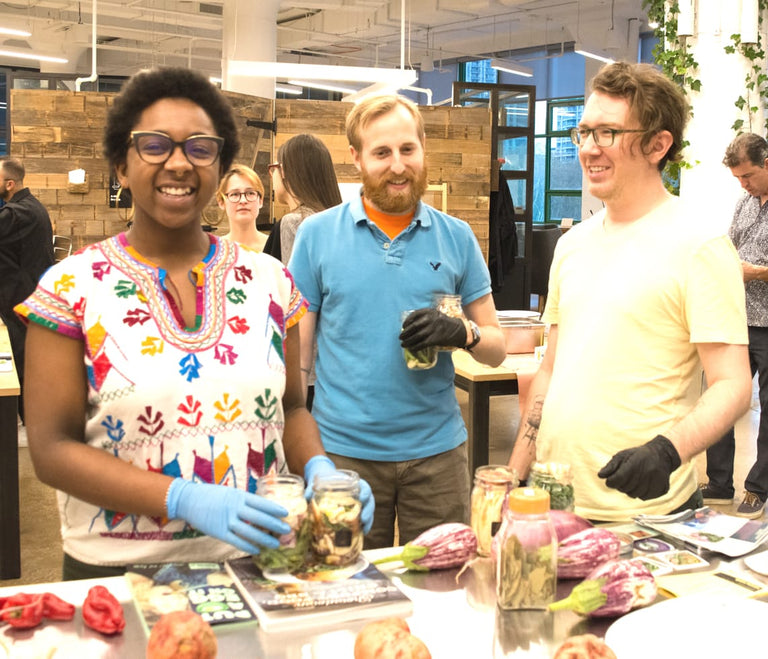Guide to Preservation: Lacto-Fermentation

One of the simplest ways to ferment vegetables and fruits, while preserving their nutritional value and taste, is lacto-fermentation. This process is commonly used in some of our favorite treats like pickles, kimchi and sauerkraut. It requires little ingredients and materials, in fact, you probably have everything you need in your kitchen right now.
The process of lacto-fermentation uses salt to break down the bacteria in your produce. The “bad” bacteria can’t tolerate the salt, and is wiped out leaving you with only good bacterias. The bacteria that survives the salt is called Lactobacillus (where this method gets its name). Lactobacillus converts the sugars that are already found in fruits and vegetables into lactic acid, which preserves the taste, nutrition and texture of your produce.
Unlike canning, which usually involves sterilization and is intended for long term storage and preservation, lacto-fermentation is a fermentation, pickling and preserving process that doesn’t last quite as long. Fermented fruits and vegetables are chalk full of probiotics and other essential gut nutrients, it’s also a wonderful way to extend the life of some veggies found in your Local Roots share.
Tips for safe, long keeping:
- Keep sealed and avoid any excess air in your jar
- Store in a cool dark place
- Keep an eye out for mold (specifically black mold or any dark discoloration, white milky substance is fine)
- A good lacto ferment will have a slightly sour, but pleasant smell and crisp texture.
- Rotted fermentation will have an unpleasant smell and slimy brine and texture.
This process of fermentation works great with firm vegetables, like those often featured in our fall shares. Some of our favorite vegetables to ferment this way include cabbage, green beans, radishes and carrots. This process gives your veggies an extra punch of flavor, adding an element of excitement to your boring weekday salad and the perfect complement to your dinner. You can also try it with fruits like plums and apples to add a twist to some chutney or a different type of garnish for a drink, like those inspired in Mother Bar in Toronto.
NOMA, an infamous farm to table restaurant in Copenhagen, known for their ambitious experimentation and fermentations, came out The NOMA Guide to Fermentation. This book features a recipe for lacto fermented plums, an excellent treat to add to a Negroni (as seen at Mother Bar). Unlike traditional methods of lacto fermentation that submerge the vegetables in water, this one uses only salt.
Lacto Fermented Plums
Recipe from The NOMA Guide to Fermentation as told by Food Fermentation Tips
Ingredients:
- 20 grams non-iodized salt*
- ~ 2 lbs Plums (weighed with pits removed)
Special Materials:
- Vacuum sealed bag
- Kitchen Scale
Directions:
- Wash dirt from outside of plums, but leave the skin on. Then, cut the plums in half and remove the pits.
- Toss the halved plums to be covered evenly with salt. Place inside of a vacuum sealed back, allow a little space between the plums. Remove all air and place in a warm place to ferment for 5-7 days, or until they’ve fermented to taste (depending on how sweet or sharp you like). During the fermentation process, be sure to “burp” your bag to release the gas.
- Once fermented to your liking, you can keep in a jar or submerged in vinegar. Storing it in the fridge will also decrease or completely stop the process of further fermentation.
* NOTE: The ratio of plums to salt is 1 kg: 2 grams of salt. If you have more of less plums, you can adjust based on this ratio.
Article by Local Roots NYC volunteer Sylvie Florman
Rather have a taste first?
Local Roots Experiences are fun, pop-up events where we bring the farm to you!

Become a Harvest Club Pick Up Location
Are you a NY based cafe, bar, or neighborhood business? Become a Harvest Club pick up location and have community members come to your establishment each week to pick up their Local Roots harvest.
Top






